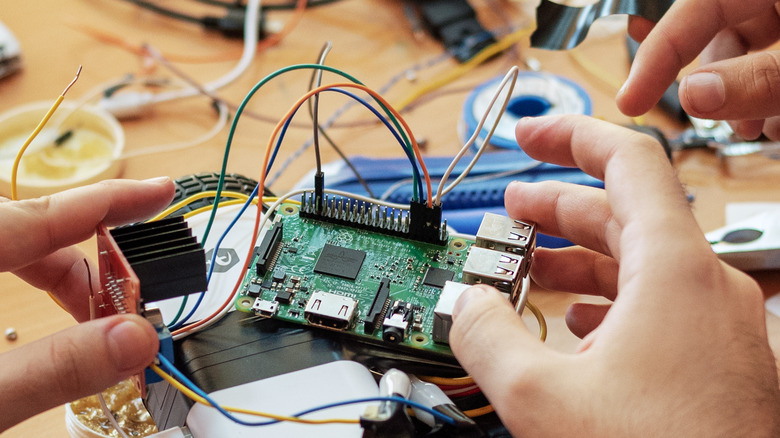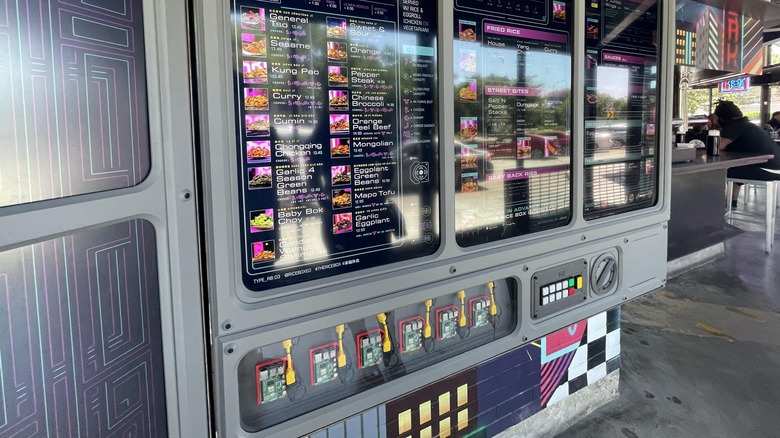5 Unusual Raspberry Pi Projects Found In The Wild
If there's one word to describe a Raspberry Pi, it would be "versatile." This small but powerful single-board computer is designed for a wide range of DIY applications, ranging from a simple media center to a multi-component weather station. That's why it came as no surprise that since its launch over a decade ago, it has already sold no less than 40 million units and powered thousands of projects for educational, personal, and even commercial use.
While a lot of hobbyists and tech enthusiasts have used the Raspberry Pi for typical tasks such as replacing their desktop computers or building smart robots with cameras and sensors, there are several projects in the wild that have taken the DIY game to a whole other — and quite unusual — level. Even better, some of the most creative and out-of-the-box Raspberry Pi projects are ones you can try to replicate at home.
Drive-thru signage
How many Raspberry Pi 4 boards do you need to make a digital menu signage? According to this Chinese/American restaurant based in Houston, Texas, it takes six apparently.
The Rice Box takeout joint is designed to look like a dining establishment from the future, complete with its sci-fi-inspired interior and flashy neon lights. But to take it up a notch, they decided to make their menu signage even techier: by using Raspberry Pi 4 boards for the screens and displaying them, too. The six Raspberry Pi 4 computers are connected to six screens, three of which show the takeout restaurant's menu, and the other three which are seemingly added just for the cool factor.
From the photos taken by Reddit user u/Paimonforsale who spotted the futuristic Raspberry Pi-powered takeout signage, it appears that the boards were used solely for display purposes. No other pins or ports were utilized. While the restaurant didn't take advantage of the single-board computer's full capabilities, it's still an interesting and creative use of RPis in a place you'd least expect it.
Beer can keyboard
Beer cans typically get upcycled into plant pots and candle holders, but this Romanian company decided to turn them into an unusual keyboard instead. The Beer Cans Keyboard was developed as part of the Webstock social media event in Romania in 2012, where attendees used it to type their details for an event sponsor's contest.
Composed of 44 beer cans, the project worked just like any old keyboard. However, instead of mechanical or membrane buttons, each of the cans was equipped with capacitive sensors that output a specific letter or symbol when touched. The sensors were connected to an Arduino, which, in turn, was hooked up to a Raspberry Pi computer complete with a plasma display. While the project is a terrible idea to use at home (who has a workstation wide enough for 44 beer cans?), it was a great way to keep the attendees engaged and entertained. They just needed a little patience and hard work to use the novelty keyboard.
Internet-controlled car horn
Sure, using a Raspberry Pi to create home security cameras and a smart vacuum cleaner sounds cool, but who says you can't use it for pranks, too? The internet-controlled car horn is easily one of the most unusual Raspberry Pi projects out there and probably the most fun to make and deploy. Aside from the single-board computer and the car horn, it uses a relay board, a 12-volt battery, and a Raspberry Pi-compatible camera, such as the official module or just any old webcam.
The project leverages the already developed WebIOPi that connects the car horn to the internet and allows you to control it from any browser. Once set up, you can simply go to the server, log in, and see the real-time camera footage on the user interface. There's also a button there to turn the horn on and off, annoying anyone in the house.
Piano stairs
You might have read about installing Raspberry Pis inside mobile robots and submersible drones. But software engineer Bonnie Eisenman and her two friends decided to forego the typical route and put this single-board computer in the most unusual of places: a stairwell. Developed for HackPrinceton 2013, Eisenman's Piano Stairs project turns six steps of a stairwell into a musical instrument you can play with your feet. It uses a Raspberry Pi connected to a speaker and an Arduino with six pairs of photoresistors and flashlights.
The photoresistors are installed on one side of the stairs and the flashlights on the other, forming a tripwire. When an object like a shoe blocks the light coming from the flashlight, it will send a signal to the Raspberry Pi to play a particular tone. The six steps correspond to six different tones, so you can play a complete song as you go up and down the stairwell. Who knew something as boring as a stairwell can become fun using a Rasberry Pi?
The project, however, is limited to six steps as the Arduino only comes with six analog pins. If you plan on developing it at home and using more steps, you need to modify the hardware requirements like replacing the Arduino with a Pi Cobbler Breakout Board and an Analog to Digital Converter for the Raspberry Pi.
Bird repellant
If you think a Raspberry Pi on a stairwell is unusual, wait until you learn about a Raspberry Pi inside a bird. RoniBandini on Instructables created a Raspberry Pi-powered bird repellant in hopes of stopping the birds in their backyard from pestering them constantly.
This unusual Raspberry Pi project scares away the feathered enemies with an artificial owl that's fitted with a PIR motion sensor, two red LEDs, and a speaker. Every time the motion sensor detects any movement within range, it will light up the red LEDs in the owl's eyes and produce a hawk-like cry to drive away the birds. You can also replace the sound with other scary ones of your choosing.
While the owl might not be an effective solution for every bird specie, the project is a great opportunity to get started with using Raspberry Pi; it's really easy to replicate and needs only a few electronic components to work. You won't even need to solder anything as you can use a small breadboard to make the circuit.

